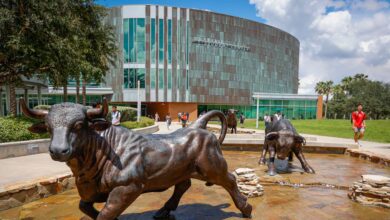Tampa is simultaneously advancing transportation, stormwater/flood protection, and water-quality projects. On the roads, the I-275 widening in Pinellas (express lanes) ties into the new Howard Frankland Bridge span and the Gateway Expressway network. In the city, capital dollars are moving into permanent generators for stormwater pump stations, a faster Pump Station Rapid Response playbook, and neighborhood drainage fixes. On the water side, the Howard F. Curren Advanced Wastewater Treatment Plant is in a multi-year upgrade to boost reliability and nitrogen removal, protecting Hillsborough Bay as the metro grows.
What’s being built (quick map of the work)
- I-275 Express Lanes (Pinellas segment). Crews are adding tolled express lanes along a key stretch of I-275 and reworking interchanges to reduce choke points. When complete, the lanes are designed to provide a faster, more predictable option during rush hour and storm evacuations and to dovetail with improvements near the Westshore interchanges on the Tampa side.
- Howard Frankland Bridge transition. Traffic now uses the new span; demolition of the old bridge and final tie-ins continue. The Frankland is the lynchpin for Bay-to-Bay commutes, cruise/airport traffic, and hurricane egress—every downstream upgrade benefits from its added capacity and modern shoulders.
- Gateway Expressway & network effects. As Pinellas links harden (Gateway/Gandy/118th), the region gets more route choices and fewer single-point failures when a crash or storm surge disrupts a corridor.
Why it matters
- Commute reliability: Express lanes + modern shoulders on the Frankland = fewer choke points and more predictable airport, cruise-port, and game-day runs.
- Flood protection: Generators at pump stations mean quicker de-watering after outages; fewer flooded intersections and faster neighborhood recovery.
- Water quality: Curren’s upgrade supports cleaner bay water, fewer odor/overflow risks, and capacity headroom for growth — crucial for waterfront businesses and recreation.
Flooding, stormwater, and neighborhood resilience
- Permanent backup power at pump stations. The City is funding fixed generators at critical stormwater pump sites so stations can run through outages and pop back online quickly after storms.
- Rapid-response staffing & parts on hand. A formalized Pump Station Rapid Response Team and pre-staged parts reduce downtime when the next Helene- or Milton-style system rolls through.
- Drainage hot-spots and complete-street fixes. Beyond the big pumps, the program folds in local drainage improvements (inlets, outfalls, culvert repairs) and complete-street elements where practical, so corridors function better in heavy rain without sacrificing safety.
Business & growth lens
- Predictable logistics: Airport access and last-mile delivery become less fragile, which helps hospitality, events, and regional suppliers.
- Lower risk profile: Flood hardening and wastewater reliability reduce business interruption and can improve insurability for restaurants, clinics, hotels, and manufacturers.
- Jobs now, competitiveness later: Skilled-trade work today; stronger site-selection story tomorrow when companies benchmark commute reliability and climate readiness.
Timeline & milestones
- 2025–2027: Lane additions and interchange work on I-275; Howard Frankland old-span removal and final tie-ins; Gateway Expressway linkages.
- This budget cycle: Permanent generator installs, staffing/ SOPs for pump-station rapid response, targeted drainage jobs that deploy fast.
- Multi-year: Current AWWTP process/electrical upgrades with phased commissioning to keep service online.
Clean water: The Howard F. Curren Upgrade
Nearly $200 million in upgrades are underway at Tampa’s Howard F. Curren Advanced Wastewater Treatment Plant, with another $80 million set to start soon—part of a major overhaul of aging infrastructure that serves homes, businesses, schools, and hospitals from the Pasco County line to I-75 and south to MacDill Air Force Base. In all, more than 630,000 people depend on Tampa’s sprawling wastewater system.
Why does it matter?
Tampa’s Howard F. Curren AWWTP is getting a multi-phase overhaul to improve reliability, add redundancy, and increase nitrogen removal capacity. For residents and waterfront businesses, that means cleaner bay water, fewer odor/overflow risks, and a plant that can handle growth and storm stress without compromising service.
Why you’ll feel it: Most of this work is behind the scenes, but it protects water quality, safeguards public health, and supports development without trading off environmental gains Tampa has made over decades.




